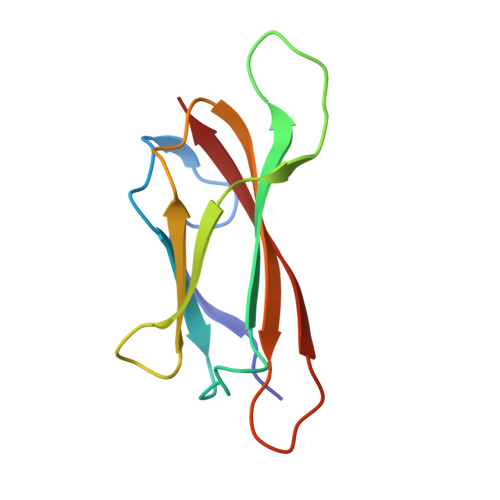Intermolecular Transfer of Copper Ions from the Copc Protein of Pseudomonas Syringae. Crystal Structures of Fully Loaded Cu(I)Cu(II) Forms.
Zhang, L., Koay, M., Maher, M.J., Xiao, Z., Wedd, A.G.(2006) J Am Chem Soc 128: 5834
- PubMed: 16637653
- DOI: https://doi.org/10.1021/ja058528x
- Primary Citation of Related Structures:
2C9P, 2C9Q, 2C9R - PubMed Abstract:
CopC is a small soluble protein expressed in the periplasm of Pseudomonas syringae pathovar tomato as part of its copper resistance response (cop operon). Equilibrium competition reactions confirmed two separated binding sites with high affinities for Cu(I) (10(-7) > or = K(D) > or = 10(-13) M) and Cu(II) (K(D) = 10(-13(1)) M), respectively. While Cu(I)-CopC was converted cleanly by O2 to Cu(II)-CopC, the fully loaded form Cu(I)Cu(II)-CopC was stable in air. Variant forms H1F and H91F exhibited a lower affinity for Cu(II) than does the wild-type protein while variant E27G exhibited a higher affinity. Cation exchange chromatography detected each of the four different types of intermolecular copper transfer reactions possible between wild type and variant forms: Cu(I) site to Cu(II) site; Cu(II) site to Cu(I) site; Cu(I) site to Cu(I) site; Cu(II) site to Cu(II) site. The availability of an unoccupied site of higher affinity induced intermolecular transfer of either Cu(I) or Cu(II) in the presence of O2 while buffering concentrations of cupric ion at sub-picomolar levels. Crystal structures of two crystal forms of wild-type Cu(I)Cu(II)-CopC and of the apo-H91F variant demonstrate that the core structures of the molecules in the three crystal forms are conserved. However, the conformations of the amino terminus (a Cu(II) ligand) and the two copper-binding loops (at each end of the molecule) differ significantly, providing the structural lability needed to allow transfer of copper between partners, with or without change of oxidation state. CopC has the potential to interact directly with each of the four cop proteins coexpressed to the periplasm.
Organizational Affiliation:
School of Chemistry and Bio21 Institute, University of Melbourne, Parkville, VIC 3010, Australia.
















